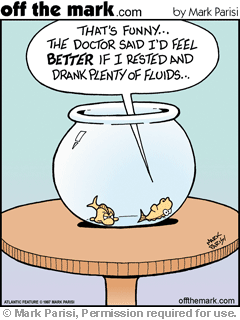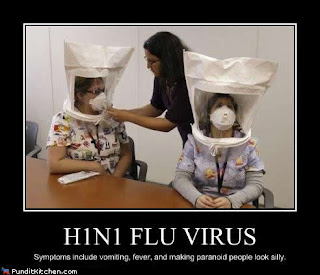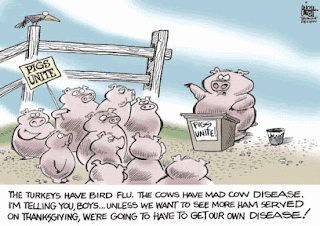 Alert! The swine flu has marched its coughing army of viral genetics into your safe haven... it has blown its way into your home.
Alert! The swine flu has marched its coughing army of viral genetics into your safe haven... it has blown its way into your home.The porky enemy has infiltrated your territory. The siege is over and the swine have broken through your defenses. Your walls are breached and your pants are down. There are piglet particles everywhere.
Some of your team have been compromised, maybe even your second-in-command (your spouse). What do you do? Are you going to give up? Are you going to throw in the towel and run out screaming, 'the piggies are coming, the piggies are coming'? No! Heck, no!
You are one tough mommy! You don't fall weak at the sight of puke and pustules. You are supermom or superdad. Your motto is: 'Never give up! Never surrender!' Okay, so that's the motto from Galaxy Quest, but you borrowed it and tattooed it on your buttock.
So now that you have built up the resolve to take down the enemy swine, what do you do next? You do what any normal military person would do, you hedge off the areas that have been compromised, tend to the wounded, and do your best to keep from becoming a military casualty yourself.
At this point in the war on H1N1, you know that the time for bellyaching and fear-mongering is over. Now is the time for buckling down, rolling back your sleeves, and heading N95 mask first into the pig pen.
You remember all those old movies about the crusty old army sergeant that forges back into the line of fire to save a fallen comrade: well, that crusty old sergeant is you. This is your moment; you have trained for it and you are going to kick some swine flu butt. You stand in front of your sickly family and shout, "Are you with me?!"
Okay, so your family looks at you as if you are the village fruitcake. Maybe the two-year-old applauds, but they all return to their beds moaning and you are left to tackle the flu on your own.
Well, you're not entirely on your own; the CDC has established some steps to lessen the spread of flu in the home. They have offered you the almighty handbook of "Security Lock-Down 101."
 Rule 1: Solitary confinement. The CDC suggests keeping the sick person away from the other members of the household as much as possible, especially those that are high risk for complications from the novel H1N1.
Rule 1: Solitary confinement. The CDC suggests keeping the sick person away from the other members of the household as much as possible, especially those that are high risk for complications from the novel H1N1.I have to say here, how in the heck is that supposed to work if you have children sharing a room and the only other room in your house is the only last safe haven you have from children, or at least it is until 3 am when your toddler comes jumping into bed with you because the boogie man set up shop in their closet.
But anyway, the CDC suggests that you keep the sick person or persons in a room separate from the common areas of the house. ("For example, a spare bedroom with its own bathroom.") And keep the designated sick room shut at all times.
Oh yeah, a three year old child is going to love the solitary confinement while they feel like crap. How many three-year-olds do you know of that enjoy being absolutely alone when they need comfort from mommy or daddy? And I doubt the six-year-old sick child is going to stay put.
The curious thing about children is that they can and will play up until they are so sick that they can hardly stand. At that time, they begin to shows signs of lethargy and confusion. At that time, they should be visiting ye ol' emergency room, sporting a face mask. While we adults, the first moment we feel ill, we're done playing. (I'll talk about this phenomena more in my posts on hypo- and hyperthermia.)
Rule 2: Careful Transport of the Compromised. The CDC suggests that if the sick person does have to walk through they should wear a mask.
Rule 3: Hedge off the Enemy, Don't Allow it to Compromise Other Bases. Try to keep visitors to a bare minimum. Children when sick can transmit the virus up to two weeks after the last symptoms have gone. So if their friends come over to visit, there is a high likelihood that they can catch the disease and bring it home to their own families. And I'm sorry, misery shouldn't like company.
Rule 4: Keep Yourself From Becoming a Military Casualty. When holding your sick child to comfort them, hold them so that their chin is over your shoulder and turn your head away when they cough. If you come down sick then who cares for your loved ones.
Also, if possible try to wear protective gear to prevent the spread of infection. When leaving the patient's room, remove the protective gear to a designated location and wash your hands.
Rule 5: Clean the Barracks. Laundry should be washed with hot water and bleach if possible. Don't hug laundry to yourself when placing it in the washing machine. Use a laundry basket and gloves. After handling laundry, wash your hands and wipe the area with disinfectant.
In the kitchen, designate a specific set of dishes and utensils for your sick loved one to use. And wash those dishes in hot water in a dishwasher, if possible. Try to keep those dishes separate from the rest of your family's dishes.
Wipe down surfaces, bathrooms, door knobs, etc. with disinfectant sprays constantly.
Rule 6: Call in for Backup When the Enemy Becomes to Powerful. I have listed a series of signs in past blogs of when to go to the ER. Keep in mind that the H1N1 comes on fast. It doesn't wait for a few days to gather its strength, it hits you like a ton of bricks on the fastlane.
A lot of primary care providers are concerned, because of the possibility that patients can come into their offices with seemingly harmless symptoms and within less than 24 hours are in deep distress with full-blown H1N1.
On a single day, a particular hospital reported that there were 50 admissions for H1N1 with 19 of them being transferred to intensive care. The majority of these cases appeared at first looking like they had the common cold.
Recognize when to cut your losses and go to seek professional assistance.
Rule 7: Like all Things, This too Shall Pass. The truth is that I have seen many cases of H1N1 in this last week, where the family has recovered together. Careful planning and attention to warning signs will help you and your family stay safe this flu season.
On a serious note, please keep hydrated. Please get enough rest and vitamins. And for the love of Miss Piggy, please seek medical attention when you start feeling an illness come on quickly.
If you have any more questions concerning H1N1, please utilize the comments section of this blog. I will try to reply to your questions as soon as possible.









































